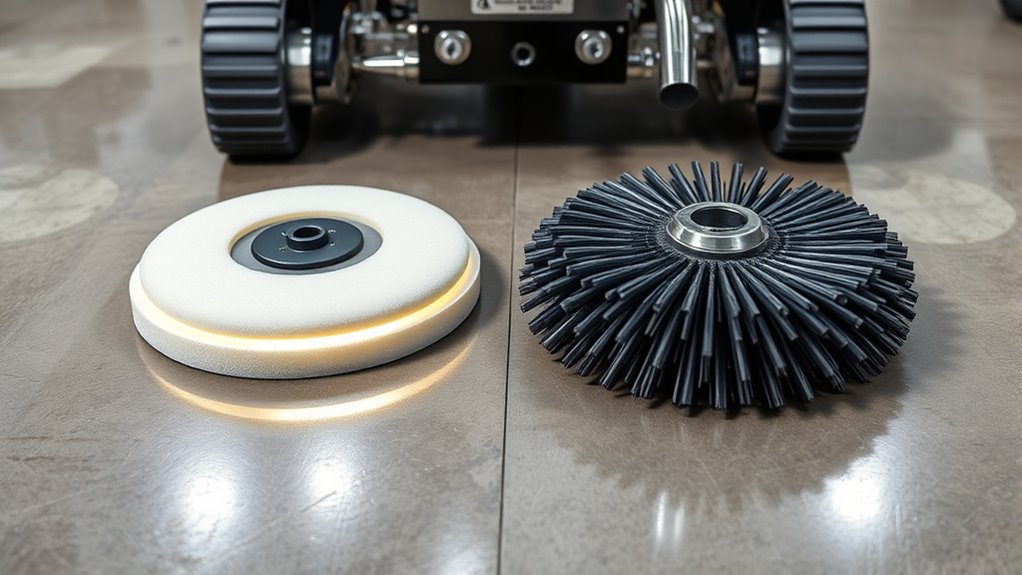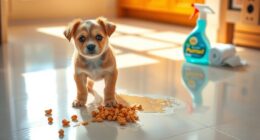When setting up an auto-scrubber for polished concrete, choosing between pads and brushes depends on your cleaning needs. Pads are gentle and ideal for polishing or light scrubbing, while brushes are better for deep cleaning or stain removal. Properly securing and testing your attachments guarantees even contact and prevents damage. Adjust speed and pressure carefully to protect your surface. Keep in mind, understanding the best attachment for your task helps maintain your polished concrete’s look—more tips are ahead.
Key Takeaways
- Choose pads for gentle polishing and scrubbing; use brushes for deep cleaning and stain removal on polished concrete.
- Ensure attachments are compatible with your auto-scrubber model and securely mounted before use.
- Adjust equipment speed and pressure to prevent surface damage and ensure even contact with the floor.
- Regularly inspect and clean attachments after each use to maintain effectiveness and prevent buildup.
- Test setup on small areas first to verify effectiveness and avoid unintended damage to the polished surface.

Setting up an auto-scrubber for polished concrete guarantees a thorough and efficient cleaning process. Your choice between a pad or brush depends on the specific needs of your flooring and the results you want to achieve. Both options have their advantages, but understanding how to properly set up your equipment is key to maximizing cleaning performance. First, ensure your auto-scrubber is in good condition through regular equipment maintenance. Check for any worn or damaged parts, especially the brushes or pads, and replace them as needed. Proper maintenance prevents unnecessary downtime and ensures your machine functions smoothly. When it comes to cleaning chemicals, selecting the right solutions is critical. Use cleaning chemicals formulated specifically for polished concrete to avoid damage or dulling the surface. Dilute them properly, following manufacturer instructions, to ensure effective cleaning without residual buildup. Keep in mind that overuse of chemicals can leave streaks or haze, so measure carefully and rinse thoroughly when necessary. If you’re using a pad, make sure it’s compatible with your machine and suitable for polished surfaces. Pads designed for polishing or scrubbing are often soft and gentle, yet effective at removing dirt without scratching. Attach the pad securely, ensuring it spins freely and evenly contacts the floor for consistent cleaning. When opting for a brush, select one with soft bristles suited for delicate surfaces. Brushes are ideal for deeper cleaning or removing stubborn stains. Secure the brush properly to prevent wobbling or uneven contact with the floor. When setting up either attachment, double-check that the auto-scrubber is correctly adjusted for speed and pressure to avoid damaging the polished surface. Adjusting the pressure is especially important to prevent dulling the shine or causing scratches. Always test your setup in a small, inconspicuous area first to ensure compatibility. During operation, pay attention to the cleaning chemicals you’re using and how they interact with your chosen pad or brush. Proper equipment maintenance extends beyond just replacing worn parts; it also involves regularly inspecting and cleaning attachments to prevent buildup that could lead to ineffective cleaning or damage. After each use, rinse and clean your attachments thoroughly to remove residual chemicals and dirt. This routine prolongs their lifespan and maintains cleaning efficiency. Additionally, understanding the contrast ratio of your equipment can help determine the quality of the cleaned surface and how well it will reflect light. By carefully selecting and setting up your auto-scrubber with the appropriate pad or brush, combined with the right cleaning chemicals and diligent equipment maintenance, you ensure your polished concrete floors stay gleaming and well-maintained. Proper setup not only enhances cleaning results but also preserves the integrity and appearance of your floors over time.
Frequently Asked Questions
How Often Should I Change the Auto-Scrubber Pads or Brushes?
You should change your auto-scrubber pads or brushes when they show signs of wear, typically every 50-100 hours of use. Keep an eye on pad lifespan and brush durability—if they become frayed, cracked, or lose their effectiveness, it’s time to replace them. Regularly inspecting your equipment guarantees peak cleaning performance and prevents damage to your polished concrete surface. Replace pads or brushes promptly for the best results.
Can I Use the Same Setup for Different Types of Polished Concrete?
You can’t use the same setup for different types of polished concrete if you want ideal results. Equipment versatility is limited by surface texture, gloss level, and finish, so you need to adapt your setup for each job. Consistency in your setup ensures quality and efficiency, but changing pads or brushes based on the specific polished concrete type helps prevent damage and achieve the desired shine. Stay flexible and attentive to surface needs.
What Maintenance Is Required for Auto-Scrubber Components?
You need to regularly inspect your auto-scrubber’s pad and brush components to guarantee peak performance. Check pad durability and replace pads when they show signs of wear or damage. Similarly, monitor brushes for wear and replace them promptly to maintain cleaning efficiency. Regular maintenance also includes cleaning the squeegee, filters, and ensuring proper fluid levels. These steps help extend your equipment’s lifespan and keep your polished concrete floors pristine.
Are There Environmental Considerations When Choosing Pads or Brushes?
Choosing eco-friendly pads or brushes can massively reduce your environmental impact. Look for materials made from recycled or biodegradable resources to minimize waste and avoid harmful chemicals. Proper waste disposal of used pads or brushes is essential to prevent pollution. By prioritizing sustainable options, you not only protect the environment but also promote responsible cleaning practices that support a healthier planet for everyone.
How Do I Troubleshoot Common Auto-Scrubber Setup Issues?
To troubleshoot common auto-scrubber setup issues, start by checking the user interface for error messages and verify settings are correct. Confirm the power supply is stable and properly connected, as fluctuations can affect performance. If the scrubber isn’t operating smoothly, inspect the pads or brushes for wear or misalignment. Regularly resetting the system and consulting the user manual can also resolve most issues quickly.
Conclusion
Choosing the right auto-scrubber setup for polished concrete isn’t just about equipment—it’s about creating a space that feels welcoming and professional. When you select the perfect pad or brush, you might find yourself surprised at how effortlessly your floors shine, transforming your environment. Sometimes, the smallest choices lead to the biggest results. So, trust your instincts and enjoy the beauty that comes from a well-chosen setup—your polished concrete will thank you.









